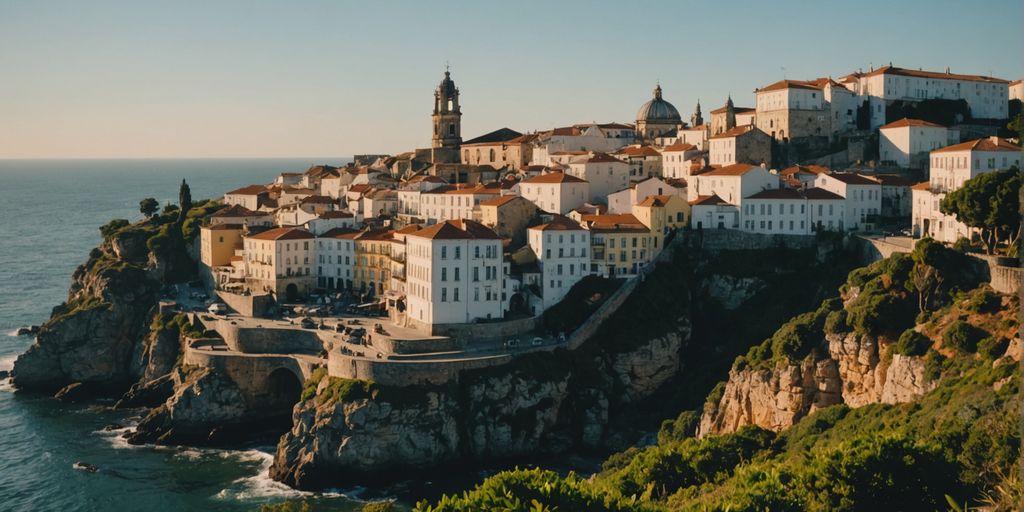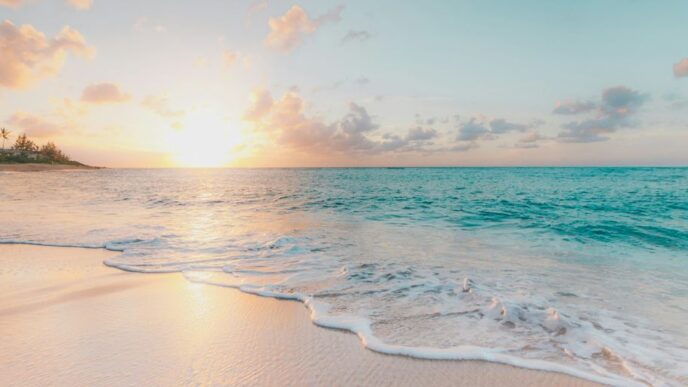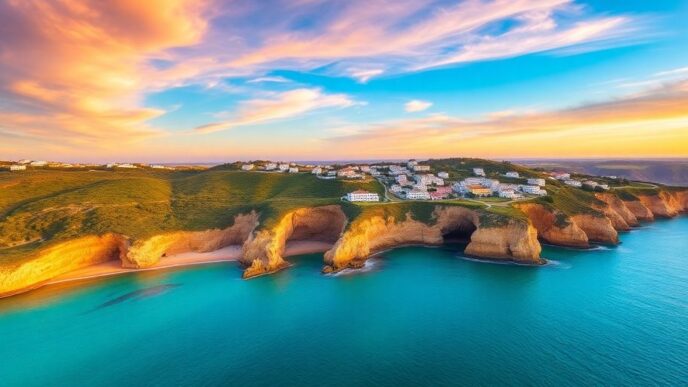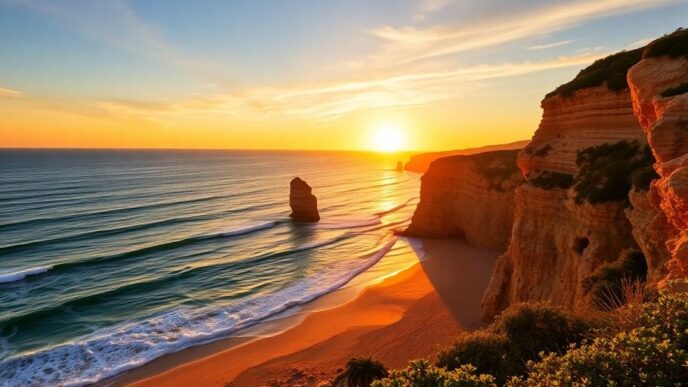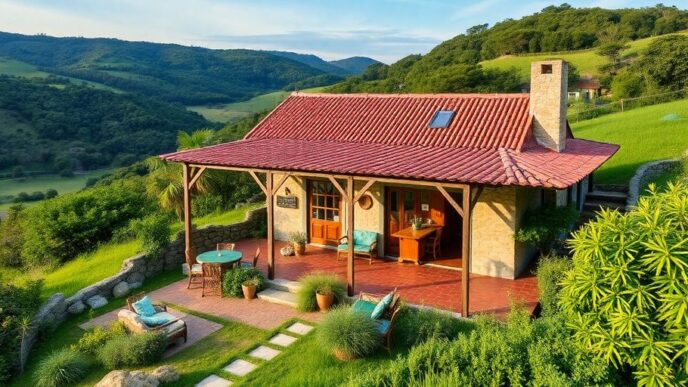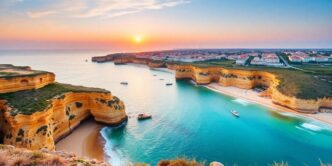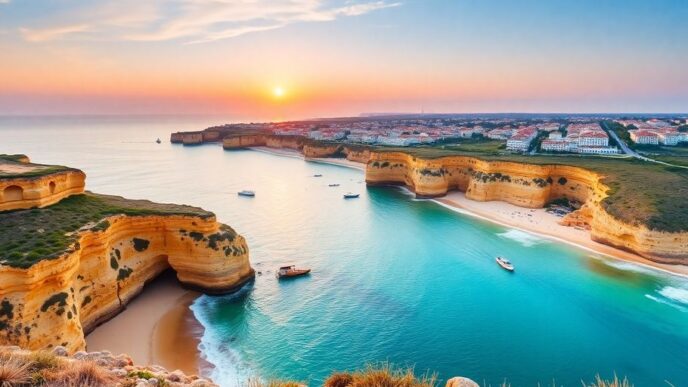Lisbon
Lisbon, the vibrant capital of Portugal, blends old traditions with modern charm. Its hilly streets and colorful neighborhoods are perfect for exploring. The iconic yellow trams add to the city’s unique vibe.
Don’t miss the historic district of Alfama. Its narrow streets and traditional Fado music venues give a glimpse into the city’s past. For stunning views, head to the imposing São Jorge Castle. You can see the whole city and the Tagus River from there.
Another must-see is the Belém Tower. It stands as a symbol of Portugal’s Age of Discovery. Lisbon is also famous for its delicious food. Try the custardy sweetness of pasteis de nata and the savory zing of bacalhau.
Lisbon is one of the most popular destinations in Portugal. It tops many lists of the best places to visit in Europe. By day, explore steep and winding alleyways. By night, enjoy mouthwatering aromas and melodic Fado music.
Porto
Porto, the second-largest city in Portugal, is known for its historic center and vibrant riverside district. The Ribeira district is famous for its colorful buildings and lively riverfront promenade. The Dom Luís I Bridge stands out with its iconic double-deck metal arch.
Don’t miss the charming neighborhoods of Boavista and Foz. They offer elegant gardens and beautiful beaches, a nice contrast to the city’s urban energy. Porto is also the gateway to the Douro Valley, perfect for wine lovers.
Explore the streets of Porto and enjoy its historic charm. The city has many museums and sightseeing spots that rival the most famous European cities. São Bento station is a must-see with its beautiful azulejo tiles. Porto’s digestibility makes it perfect for a long weekend trip. You can easily explore its gardens, medieval palaces, and cathedrals before dinner.
Porto and the surrounding region offer a bit of everything for travelers. In the city, you can enjoy walking, food, and historical tours. Nearby, you can visit historic cities like Braga and Guimarães, enjoy outdoor activities in Peneda-Gerês park, and experience wine-focused activities in the Douro Valley. The coast also has great beaches backed by cute towns.
Douro Valley
The Douro Valley is a UNESCO World Heritage Site known for its stunning landscapes and terraced vineyards. It’s a paradise for wine lovers and nature enthusiasts. A leisurely cruise along the Douro River offers a picturesque journey through the valley. You can visit famous wine estates and taste the region’s renowned Port wine.
What to Do
- Visit Pinhão: This charming town is the gateway to the Douro Valley. It’s surrounded by terraced hills covered in vines.
- Wine Tours: Opt for a guided tour of the vineyards and wineries to learn about the winemaking process.
- Seasonal Visits: Consider visiting during the grape harvest season in the fall for a unique experience.
Insider Tips
- Plan Ahead: Some wine estates require advanced reservations for tours and tastings.
- Getting There: The region can be reached by train, car, or organized tours from Porto or nearby towns.
The Douro Valley is perfect for those seeking relaxation and scenic beauty. Elderly travelers will also find it enjoyable without strenuous activities.
Sintra
Sintra is a picturesque town nestled in the forested hills of the Serra de Sintra. It’s famous for its romantic architecture, lush gardens, and fairy-tale palaces. The colorful and whimsical Pena Palace is a symbol of 19th-century Romanticism. The Moorish Castle offers panoramic views of the town and countryside. The mystical Quinta da Regaleira estate, with its enigmatic gardens and underground tunnels, adds an air of mystery to Sintra’s allure.
Must-See Attractions
- Pena Palace: A vibrant, romantic palace with stunning views.
- Moorish Castle: Offers breathtaking panoramic views.
- Quinta da Regaleira: Known for its mysterious gardens and tunnels.
Insider Tips
- Arrive early to avoid peak crowds.
- Spend at least 48 hours to fully explore.
- Perfect for history buffs, nature lovers, and photographers.
Algarve
The Algarve is Portugal’s southernmost region, known for its golden beaches and sunny weather. It’s a coastal paradise with more than just sun and sand. The countryside, bordered by the Monchique and Caldeirão mountains, holds authentic villages that transport you back in time.
Outdoor enthusiasts can explore the sea caves and grottoes of Ponta da Piedade. Nature lovers will appreciate the natural beauty of Ria Formosa, a protected lagoon and wildlife reserve. The Algarve is also famous for its fresh fish and seafood, making it a foodie’s dream.
Whether you want to relax on the beach or go on an adventure, the Algarve has something for everyone. From bustling resort towns like Albufeira to tranquil villages like Salema, you’ll find a diverse range of experiences. Top attractions include:
- Zoomarine Algarve
- Praia da Falésia
- Ponta da Piedade
The Algarve is a place of escape, with tiny fishing villages and coves where jewel-bright waters are cradled by dramatic cliffs. Everyone speaks English, which is handy if you need directions. Spend your days soaking up the sun and enjoying the beautiful coastline before heading back home.
Madeira
Madeira is an island with rugged coastlines and lush landscapes. It’s perfect for outdoor adventures and peaceful getaways. The Levada walking trails are great for scenic hikes. You can explore the colorful Funchal Market, the majestic São Vicente Caves, and the enchanting Monte Palace Tropical Garden. Madeira offers a mix of nature and culture that’s hard to beat. The island’s public transportation makes it easy to get around, but be ready for some elevation changes if you’re hiking.
Azores
In the middle of the Atlantic, between the United States’ east coast and Portugal’s mainland, lies an archipelago of nine volcanic islands known for its stunning green hills, dark land, and volcanic wines.
Ponta Delgada is the capital and the largest city in Azores, and is likely where your journey will begin. A medieval city that was an important merchant port in the 15th century, it has quite a lot of history.
The Azores, an archipelago of nine volcanic islands located in the Atlantic Ocean, offers a paradise for nature enthusiasts, adventure seekers, and those yearning for an off-the-beaten-path escape. Each island presents unique landscapes, from the volcanic craters and lush valleys of São Miguel to the dramatic cliffs of Flores. Outdoor activities such as whale watching, hiking, and thermal baths in natural hot springs create memorable experiences for visitors.
Insider Tips: Consider exploring the less-visited islands, such as Pico or Santa Maria, for a serene and authentic Azorean experience, and opt for guided nature tours to fully appreciate the archipelago’s biodiversity.
Practicalities: The Azores can be reached by air from mainland Portugal, with inter-island flights and ferry services connecting the different islands. Due to their remote nature, it’s essential to plan travel and activities in advance, particularly during peak tourism periods.
The Azores archipelago, located in the Atlantic Ocean, offers stunning natural beauty and a peaceful atmosphere. From hiking to volcanic crater lakes and exploring lava tubes to swimming in natural hot springs, the Azores are full of adventurous things to do in Portugal and provide a wealth of outdoor activities, as well as a chance to immerse yourself in unspoiled nature.
Nearly halfway between the American and Portuguese coasts is the Azorean archipelago, each island as deserving of your holiday time as the next. The largest, São Miguel, is the easiest to reach by air, and is a wonderful rolling green oasis with plenty to absorb you for a few days. This is a thoroughly Azorean experience, helped by hiking trails, waterfalls and beautiful twin lakes called Lagoa das Sete Cidades. An absolute must-visit is the small village of Furnas: as the last word in volcanic power, here
Évora
Consider visiting during the festive events or cultural festivals to witness Évora’s vibrant traditions and local customs. Explore the surrounding countryside for scenic walks and visits to local wineries.
Évora is well-connected by train and bus services from major cities in Portugal. Combine a visit to the city with a countryside excursion to fully appreciate the region’s diverse offerings.
History enthusiasts, architecture admirers, and those seeking a tranquil escape amid cultural richness will appreciate the allure of Évora. Elderly travelers can explore the city’s main landmarks with relative ease and indulge in the region’s renowned gastronomy.
Coimbra
Discover Coimbra: the city of education and culture. This charming town is famous for its prestigious university and rich history. The University of Coimbra, a UNESCO World Heritage Site, is a must-see. Its grand façade, opulent libraries, and beautiful botanical garden are breathtaking.
Wander through the medieval streets and alleys of the old town. The Monastery of Santa Clara-a-Velha and the Coimbra Cathedral showcase the city’s religious roots. For a lively vibe, visit during the academic year to see students in Harry Potter-style capes.
Coimbra is also known for its vibrant nightlife. Enjoy bars and restaurants with affordable, high-quality food and drinks. Don’t miss the local cuisine, known for its hearty flavors and fresh produce.
Getting around is easy. Coimbra is accessible by train from major cities, and its compact size makes it perfect for exploring on foot. Plan your visit around the university’s academic calendar to get the full experience.
Braga
Braga is a vibrant and youthful city. It’s perfect for a quick getaway. The city is full of history and culture. You can find ancient landmarks and modern attractions side by side. The locals are friendly and always ready to chat.
Here are some must-see spots in Braga:
- Bom Jesus do Monte: A stunning sanctuary with a beautiful staircase.
- Braga Cathedral: One of the oldest cathedrals in Portugal.
- The Garden of Santa Barbara: A lovely place to relax and enjoy nature.
Braga is also known for its lively festivals and events. There’s always something happening. Whether you’re into music, food, or art, you’ll find something to enjoy. Don’t miss out on the local cuisine. The traditional dishes are delicious and worth trying.
If you’re planning a trip to Porto, consider a day trip to Braga. It’s just a short drive away and offers a different vibe. Braga is a mix of old and new, making it a unique destination in Portugal.
Frequently Asked Questions
What is the best time to visit Portugal?
The best time to visit Portugal is during the spring (March to May) or fall (September to October). The weather is pleasant, and there are fewer tourists.
What are the must-see attractions in Lisbon?
In Lisbon, don’t miss the historic Belem Tower, the Jeronimos Monastery, and the vibrant Alfama district. Also, take a ride on the iconic Tram 28.
How can I travel between Lisbon and Porto?
You can travel between Lisbon and Porto by train, bus, or car. The train is the fastest and most comfortable option, taking about 2.5 to 3 hours.
What is special about the Douro Valley?
The Douro Valley is famous for its stunning landscapes and vineyards. It’s a great place to taste Port wine and enjoy river cruises.
Why should I visit Sintra?
Sintra is known for its fairy-tale palaces, like the Pena Palace and the Moorish Castle. The town is surrounded by lush hills and beautiful gardens.
What activities can I do in the Algarve?
In the Algarve, you can enjoy beautiful beaches, water sports, and explore charming towns like Lagos and Faro. It’s also great for golfing and hiking.
What makes Madeira a unique destination?
Madeira is known for its year-round spring-like weather, stunning landscapes, and rich flora. It’s perfect for hiking, whale watching, and enjoying local cuisine.
Are the Azores worth visiting?
Yes, the Azores are worth visiting for their natural beauty, hot springs, and outdoor activities like hiking, whale watching, and diving.

